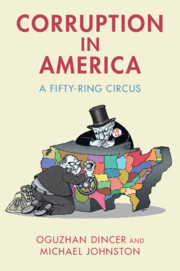Refine search
Actions for selected content:
108 results
4 - US Business Cycles 1954 through 2020
-
- Book:
- US Business Cycles 1954–2020
- Published online:
- 22 December 2025
- Print publication:
- 18 December 2025, pp 53-105
-
- Chapter
- Export citation
A cross-sectional study of alcohol and drug-related medical hospital admissions among youth (15–24-years olds) in Ireland during the COVID-19 hard lockdowns
-
- Journal:
- Irish Journal of Psychological Medicine , First View
- Published online by Cambridge University Press:
- 10 October 2025, pp. 1-6
-
- Article
-
- You have access
- Open access
- HTML
- Export citation
1 - The Conservative War
-
- Book:
- Killing the Messenger
- Published online:
- 05 September 2025
- Print publication:
- 25 September 2025, pp 9-25
-
- Chapter
-
- You have access
- Open access
- HTML
- Export citation
2 - The Progressive War
-
- Book:
- Killing the Messenger
- Published online:
- 05 September 2025
- Print publication:
- 25 September 2025, pp 26-50
-
- Chapter
-
- You have access
- Open access
- HTML
- Export citation
35 - Venous Thromboembolism
- from Subsection 4C - Clinical – Vascular
-
-
- Book:
- Observation Medicine
- Published online:
- 27 June 2025
- Print publication:
- 26 June 2025, pp 191-201
-
- Chapter
- Export citation
Chapter 1 - Why You Need to Care about Emergency Risk Communication
-
- Book:
- Risk Communication in Public Health Emergencies
- Published online:
- 05 June 2025
- Print publication:
- 19 June 2025, pp 1-24
-
- Chapter
- Export citation
7 - Abstracting Embodiment
- from Part II - Confronting Global Contradictions
-
- Book:
- Global Crisis and Insecurity
- Published online:
- 01 June 2025
- Print publication:
- 12 June 2025, pp 154-180
-
- Chapter
- Export citation
22 - Scaling Down Senior Living
- from Part IV - The 100-Year Life and Our Broader Environment
-
-
- Book:
- Law and the 100-Year Life
- Published online:
- 13 May 2025
- Print publication:
- 29 May 2025, pp 296-308
-
- Chapter
-
- You have access
- Open access
- HTML
- Export citation

Amplifying Extremism
- Small Town Politicians, Media Storms, and American Journalism
-
- Published online:
- 19 May 2025
- Print publication:
- 12 June 2025
-
- Element
- Export citation
Rising prevalence of depression and widening sociodemographic disparities in depressive symptoms among Filipino youth: findings from two large nationwide cross-sectional surveys
-
- Journal:
- Cambridge Prisms: Global Mental Health / Volume 12 / 2025
- Published online by Cambridge University Press:
- 14 April 2025, e51
-
- Article
-
- You have access
- Open access
- HTML
- Export citation

Corruption in America
- A Fifty-Ring Circus
-
- Published online:
- 21 March 2025
- Print publication:
- 03 April 2025
Law and Global Governance of Infectious Disease: Access to Medicines on COVID-19, AIDS, and Beyond
-
- Journal:
- Journal of Law, Medicine & Ethics / Volume 53 / Issue S1 / Spring 2025
- Published online by Cambridge University Press:
- 14 April 2025, pp. 23-28
- Print publication:
- Spring 2025
-
- Article
-
- You have access
- Open access
- HTML
- Export citation
Chapter 4 - Back and Forth with Life: Development of a Developmentalist
-
-
- Book:
- Pillars of Developmental Psychology
- Published online:
- 14 February 2025
- Print publication:
- 20 February 2025, pp 32-43
-
- Chapter
- Export citation
Epilogue
-
- Book:
- Modern Britain, 1750 to the Present
- Published online:
- 14 January 2025
- Print publication:
- 30 January 2025, pp 526-535
-
- Chapter
- Export citation
Introduction
-
- Book:
- State Building in Cold War Asia
- Published online:
- 18 December 2024
- Print publication:
- 21 November 2024, pp 1-35
-
- Chapter
- Export citation
2 - External Shocks
-
-
- Book:
- The Conservative Effect, 2010–2024
- Published online:
- 24 July 2024
- Print publication:
- 27 June 2024, pp 37-70
-
- Chapter
- Export citation
13 - The Policy Orientation of the EU’s Post-Covid NEG Regime and Its Discontents
- from Part IV - Comparative Analysis and Post-Pandemic Developments
-
- Book:
- Politicising Commodification
- Published online:
- 30 May 2024
- Print publication:
- 06 June 2024, pp 323-352
-
- Chapter
-
- You have access
- Open access
- HTML
- Export citation
14 - Conclusion
- from Part IV - Comparative Analysis and Post-Pandemic Developments
-
- Book:
- Politicising Commodification
- Published online:
- 30 May 2024
- Print publication:
- 06 June 2024, pp 353-358
-
- Chapter
-
- You have access
- Open access
- HTML
- Export citation
14 - Joe Biden’s America
-
- Book:
- How Government Built America
- Published online:
- 08 May 2024
- Print publication:
- 09 May 2024, pp 167-175
-
- Chapter
- Export citation
